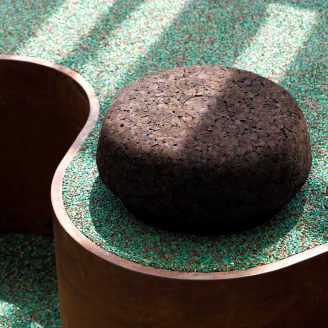Marking a new development in their long term research on urban wellbeing, ecoLogicStudio, London- and Turin-based design innovation firm, completes the third iteration of their AirBubble design concept. The restorative space conceived for a Swiss consumer healthcare company establishes a new symbiosis between nature and humans.
The AirBubble restorative space is the world’s first biotechnological healthcare garden that combines air-purifying algae cultures with medicinal plants. The project pioneers a new spatial concept balancing work, mental and physical health, relaxation, and interaction among employees from diverse departments. Moreover, it offers a multi-sensory experience enhanced by the oxygen bubbling and the scents of fresh herbs and flowers.
Located in Nyon (Switzerland), in the green area surrounding the factory grounds, the project is part of a wider vision called AirCampus. It includes the new AirBubble restorative space; the AirOffice – a symbiotic indoor workspace combining advanced gardening and air filtration; and the recently launched AIReactor, the biotechnological desktop air-purifier. AirCampus is conceived as a pioneering architectural solution for health and wellbeing in the workplace, from indoor to outdoor spaces and from physical to mental health. As a bio-design innovation project, the AirBubble restorative space is a replicable and scalable architectural system that can be installed into any work environment globally.
The project brings to Nyon a new perspective on the relationship between workplace and landscape design by reinventing the model of the pre-industrial botanical garden and surpassing that of today’s healthcare industry.
“We researched the origins of pharmaceutical manufacturing by studying the medicinal garden of Padua in Italy, where medicinal essences and plants were grown as part of a community park. We then translated this concept into the biodigital era, where substances can once again be cultivated in the public realm” says Marco Poletto, co-founder of ecoLogicStudio.
The AirBubble restorative space integrates the PhotoSynthetica™ technology which has been developed by ecoLogicStudio since 2018 within the namesake academic consortium.
The AirBubble restorative space is composed of a 6 metres high cylindrical timber structure connected at 3 levels, wrapped in an ETFE membrane, sitting on the top of a landscaped mound. The middle section of the wooden structure hosts 36 large bioreactors in borosilicate glass which contain 350 litres of living green Chlorella algae cultures that can filter a flow of polluted air of 150 litres/minute. While the liquid medium washes particles, the algae actively eat the polluting molecules as well as carbon dioxide to then release fresh clean oxygen. The filtering process is enhanced by the architectural morphology of the AirBubble restorative space: the inverted conical roof membrane further stimulates the air recirculation and natural ventilation.
The white bubbling sound of the algae gardening system masks the noise of the truck loading dock, creating a calming atmosphere ideal for relieving mind and body stress. Additionally, the harvested biomass can be incorporated into the canteen menu as algae drinks and vegetable protein bread or used as fertilizer for the wild meadow and the set of 47 medicinal plants concentrically arranged around the central seating area.
Visitors walk in onto a rubber surface composed of a mix of light and dark green as well as shades of brown particles leading to a broad two-level seating area. Two sinuous Corten metal sheets, chosen by the architects for its weathering properties, create a central petal-like sculpture – where the roof membrane converges into a small rainwater garden. A second Corten element highlights the perimeter where 11 cork seats are fixed into the rubberized surface. The seats are made from cork-chips that have been moistened to release a natural resin, forming several dark brown cork blocks that were then CNC-cut into softer morphologies.
Designed for the lightest touch on the ground, the wooden structure is anchored with 26 ground screws. By avoiding the use of concrete posts or pier blocks, this structural solution does not disrupt the landscape and it is fully reversible. Furthermore, by implementing local plants that grow according to the season and by integrating rainwater collection, AirBubble restorative space does not use irrigation water thus preserving natural resources.
The AirBubble restorative space is encircled by a medicinal garden consisting of 47 planters. Closest to the main structure are four types of autumn and winter flowering plants; moving away from the centre, 16 species that flower in spring and summer are distributed including common medicinal plants.
The project features a monitoring system that integrates urban air pollution sensors and measures the Air Quality Index for six core pollutants: fine particulate PM2.5 and PM10, ground level Ozone (O3), Nitrogen Dioxide (NO2), Sulphur Dioxide (SO2) and Carbon Monoxide (CO). AirBubble is capable of absorbing 97% of the nitrogen and 75% of the particulate matter in the air.
The AirBubble restorative space is part of a wider project focused on raising awareness of the impact of air pollution on human health, previous chapters of this endeavour are the AirBubble playground in Warsaw, the AirBubble inflatable air-purifying eco-machine installed at COP26, COP27 and Saudi Design Festival and the AirLab presented in London.














